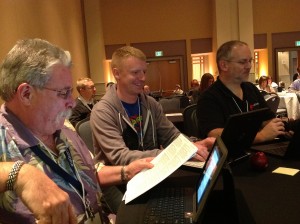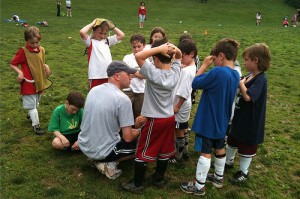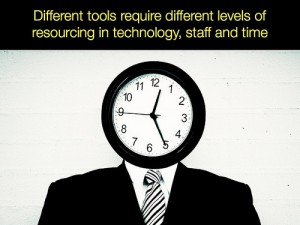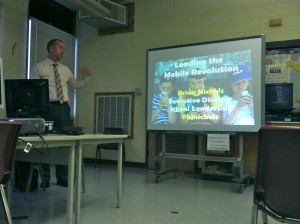It was a privilege to spend my time at ASCD as a member of the press. On Sunday at an author’s luncheon, I had the chance to speak with Heidi Hayes Jacobs along with several members of my PLN. I read her book, Curriculum 21, shortly after its publication, and also enjoyed Jacobs’s TedxNYED talk. She asks all educators to consider, “What year are you preparing your students for?” and the content and ideas she shares cause you to reflect deeply about your school’s current practices and how shifts in curriculum, organization, professional development, and the types of learning in which our students engage are imperative. Joining in the discussion were Mary Beth Hertz, Josh Stumpenhorst, and Jason Flom among others, all passionate educators looking to lead this shift in their schools.
“We need a new type of pedagogy and a new type of teacher.”
Jacobs shared her views on the varied pedagogies, including “antiquated pedagogy” (“drive-by” teaching, when there is no relationship between teacher and student); classical pedagogy (teachers are sensitive to their students and know how to engage with them, when to talk, and when to be silent; classical pedagogies are timeless), and the new pedagogy, where teachers realize they’re going to need to shift their roles. She referenced David Langford who referred to the student-teacher relationship as “colleague-colleague” relationships. We’re all colleagues… we’re all learners here.
Teachers (and administrators) need to be learners. They need to be literate in digital media, and they need to be globally literate. These two characteristics are interconnected, but different. Mary Beth shared that she’s working to establish the colleague-colleague/learner-learner relationship with her students as many of us are, and Jacobs mentioned that the latest in value-added teacher evaluation methods tied to high-stakes testing are “irrational” and will do little to support new pedagogies.
She applauded those educators who are using digital tools to establish an online presence to reflect upon their learning and for use with students, and she said it’s difficult for teachers to get started with this without knowing what “quality” looks like in this area. When she first began blogging, she looked to Mike Fisher for inspiration. We need to show teachers examples of quality digital learning and share with one another. Mary Beth described trying to explain the power of connected learning to non-connected educators as “trying to imagine a sunset in a room with no windows.”
Jacobs raved about the global forum they presented at an opening session of ASCD, where schools, students, and teachers from China, Mexico, and New Zealand came together via Skype and other digital platforms to engage in powerful learning with one another.
As for professional development, it is essential in bringing about school-wide improvement, but it must be differentiated. She reminded us to “declare our century” and shared her disappointment in examining standardized tests from the 70s whose questions mirrored those from the 90s. Where is the progress? She urged us to look at our school websites. “Does it look like you’re selling car insurance?”
A focus of Jacobs’s work has always been mapping and standards, and she shared with us her current ventures working with Common Core 360 to create the LiveBook and LivePlanner, professional development platforms for teachers. She spoke excitedly of the capabilities of the highly customizable platform, an “interactive ebook experience that gives educators the theory, research, and case studies behind curriculum integration.” She described it as a “new type of reading experience.”
The conversation shifted to ebooks and textbooks and what our kids need educational materials to be. Jacobs believe “every kid should have an annotated clearinghouse” that they, themselves, develop. We need to help children become curators and develop digital literacy skills.
I asked how school leaders can get this process started. What must every educational leader understand in order to help their schools progress? She believes every admin and teacher needs to commit to “upgrading.” Look at what you’re doing now, and make a change to at least one aspect of your leadership. When she and her team work with administrators, they spend the day forcing a culture of sharing- getting them using the tools, opening their eyes to the opportunities for globalization. She encourages admin to “get rid of meetings” and connect virtually. In regards to professional development, we discussed the #edcamp model, and how an autonomous learning model such as those provided in #edcamp settings would address the needs of a variety of adult learners. Jacobs helped us visualize a quadrant that organizes adult learning needs.
- High Curriculum, High Tech Competencies – These teachers need autonomous learning, feedback, modeling, and the opportunities to share
- High Curriculum, Low Tech Competencies – Need 1:1 support with the tools to help make ties to their strong curricular knowledge base
- Low Curriculum, High Tech Competencies – Workshop model can be successful to reach these teachers
- Low Curriculum, Low Tech Competencies – These teachers “need a career change” or “a lot of support.” (That honesty was refreshing.)
“The biggest mistake you can make is selling something in education,” she said. When administrators are working with their teams to decide how to proceed with instruction, curriculum, schedules, anything – imagine there is a student sitting at the table with your team. The guiding rule of the discussion is that any idea or concern that is raised has to be in the child’s best interest. While all team members won’t always agree, it will always be a good conversation if the child remains the focus. According to Jacobs, it’s a “no brainer” that we need to use technology in our schools. We have to prove it’s NOT good for kids before we should say it shouldn’t be used in schools, but ultimately, the first issue should not be ADULT comfort with the technology. “It’s not whether we use technology, it’s how.” Technology purchasing decisions are another great challenge today’s school administrators face. Today’s high school juniors have very different technology needs than our incoming kindergarteners do. How do administrators best manage to prioritize, purchase, manage, provide professional development for, and support learning with a large variety of tools?
Jacobs is an optimist in that she believes that many times, people are willing to change, they just don’t know how. We want our children to be able to live and learn independently of us, and frankly we’ve done students a disservice by creating such dependencies on the adults in the classrooms.
Jason keenly stated, “I want to be obsolete by the end of the year.”
Jacobs emphatically replied, “Yes!”












